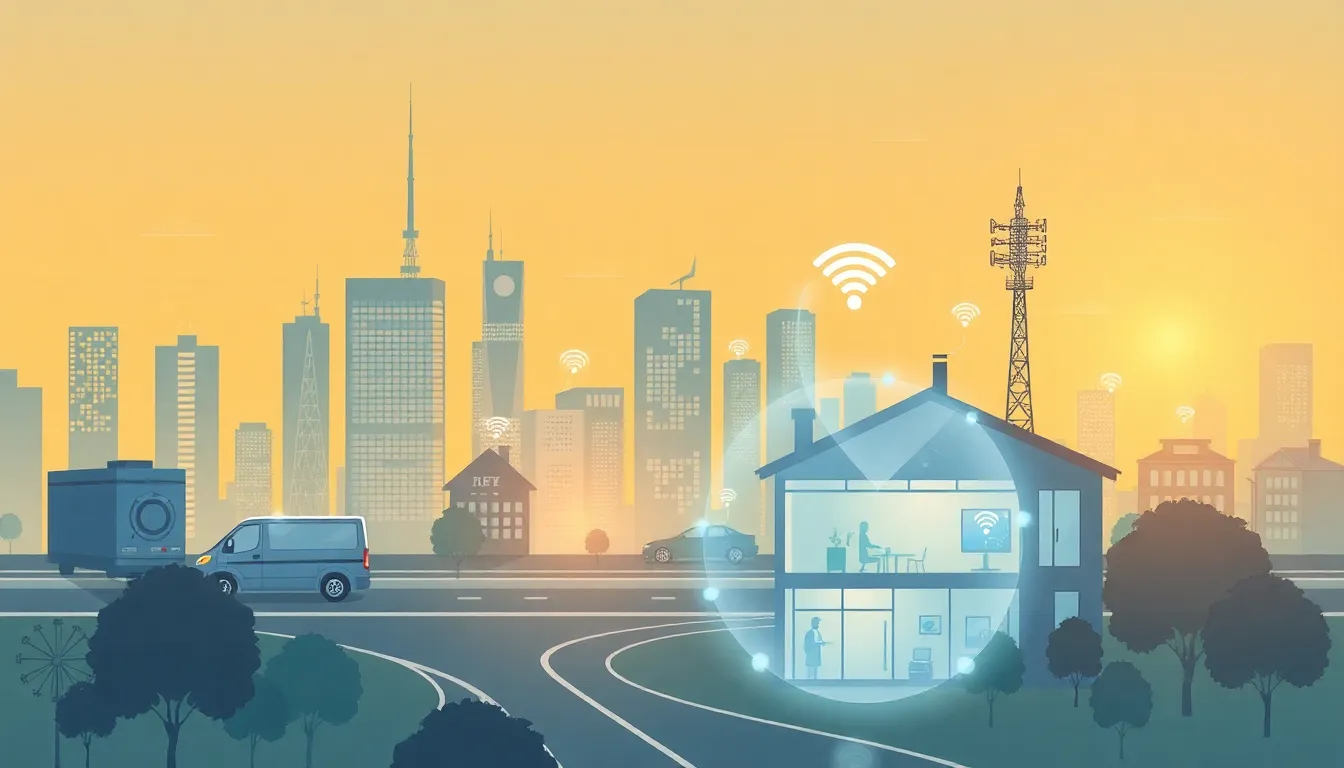In a world where your fridge can send you a text when you’re out of milk, IoT telecommunications is the unsung hero making it all happen. Imagine a universe where devices chat like old friends, sharing vital information to keep life running smoothly. It’s not just tech magic; it’s a revolution that’s reshaping how we connect, communicate, and even consume our morning coffee.
iot telecommunications
IoT telecommunications plays a vital role in connecting various devices, enabling seamless communication and enhancing user experiences. This interconnectivity transforms daily life by streamlining tasks and providing real-time data.
Definition and Importance
IoT telecommunications refers to the network that facilitates communication between IoT devices. This communication can range from simple alerts, like a low milk notification, to complex data exchanges involving sensors and monitoring systems. Wireless technologies, such as cellular networks and Wi-Fi, support these connections. Their significance lies in improving efficiency, enhancing decision-making, and driving innovation across industries. For instance, businesses leverage IoT solutions to optimize operations and reduce costs.
Key Components of IoT Telecommunications
Key components comprise various technologies and infrastructure necessary for successful IoT implementation. Devices, such as smart sensors and actuators, gather and transmit data. Connectivity options include cellular, Wi-Fi, and satellite networks, each providing unique advantages. Additionally, cloud computing stores vast amounts of data, enabling analysis and actionable insights. Security measures, like encryption and authentication protocols, protect data integrity and privacy. Scalability is also crucial, as networks must adapt to the growing number of connected devices.
Technologies Enabling IoT Telecommunications

Numerous technologies enable IoT telecommunications, enhancing connectivity and communication between devices. Each technology plays a distinct role in creating a seamless IoT ecosystem.
Cellular Networks
Cellular networks provide robust connectivity for IoT devices. They support a wide range of applications, from smart meters to connected vehicles. Various generations of cellular technology, including 4G LTE and 5G, ensure higher speeds and reduced latency. 5G, in particular, offers significant improvements, such as massive device connectivity and ultra-reliable low-latency communication. These advancements support real-time data exchanges and enable innovative solutions across industries.
Wi-Fi and Bluetooth
Wi-Fi and Bluetooth technologies facilitate local connectivity among IoT devices. Wi-Fi allows for high-speed data transfer, making it ideal for applications requiring substantial bandwidth, like smart home systems. Bluetooth, with its low energy consumption, excels in connecting short-range devices, such as wearables and smart appliances. The combination of both technologies creates flexibility, enabling devices to communicate efficiently in various environments, especially in smart homes and business settings.
LPWAN Technologies
LPWAN technologies suit scenarios requiring long-range communication with minimal power consumption. Low Power Wide Area Networks connect devices over distances ranging from a few kilometers to several dozen kilometers. Applications like environmental monitoring and smart agriculture benefit from LPWAN’s ability to transmit small amounts of data over extended periods. Technologies like LoRaWAN and Sigfox exemplify LPWAN capabilities, allowing vast quantities of devices to operate efficiently within minimal energy constraints.
Applications of IoT Telecommunications
IoT telecommunications find numerous applications across various sectors, driving efficiency and innovation.
Smart Cities
Smart cities utilize IoT telecommunications to enhance urban living. Sensor networks monitor traffic flow, reducing congestion and pollution. Smart streetlights adjust brightness based on pedestrian activity, leading to energy savings. Public safety improves with real-time surveillance and emergency response systems. Waste management benefits as smart bins signal when they need collection, ensuring prompt service.
Industrial IoT
In industrial settings, IoT telecommunications streamline operations. Connected machines allow for predictive maintenance, minimizing downtime and repair costs. Real-time monitoring enhances supply chain efficiency, thus optimizing inventory levels. Data analytics guide decision-making, improving production processes. Remote monitoring of equipment increases safety by allowing operators to assess conditions without being physically present.
Healthcare Innovations
Healthcare innovations incorporate IoT telecommunications to improve patient outcomes. Wearable devices monitor vital signs, providing continuous health data to medical professionals. Telemedicine leverages IoT technologies to connect patients with specialists for remote consultations. Medication management systems ensure adherence by alerting patients when it’s time to take their doses. These advancements facilitate efficient data sharing, thus enhancing care coordination.
Challenges in IoT Telecommunications
IoT telecommunications face several challenges that can impact their effectiveness. Understanding these obstacles is crucial for improving connectivity and enhancing user experiences.
Security Concerns
Security risks remain a prominent challenge in IoT telecommunications. Cyber attacks on devices can lead to data breaches, hacking incidents, and unauthorized control over connected systems. As the number of devices increases, vulnerabilities might multiply, making it challenging to implement uniform security measures. IoT devices often lack robust security protocols, leaving them exposed. Organizations must prioritize security by adopting advanced encryption, regular software updates, and thorough risk assessments to ensure data integrity.
Connectivity Issues
Connectivity issues pose significant hurdles for IoT telecommunications. Network consistency can falter due to high device densities or geographic limitations. As more devices connect, bandwidth can become saturated, leading to slower response times. Additionally, inconsistent coverage in rural or remote areas can hinder device performance. Strategies such as deploying advanced networking technologies and diversifying connection options can help mitigate these connectivity challenges, ensuring reliable and uninterrupted communications.
Scalability Challenges
Scalability challenges often arise as organizations aim to expand their IoT ecosystems. The rapid increase in connected devices can strain existing infrastructure, leading to bottlenecks. Maintaining optimal performance while accommodating growth demands flexible systems that can adapt efficiently. Cloud solutions and edge computing can significantly enhance scalability by distributing processing resources closer to where data is generated. Integrating such technologies supports seamless scaling and helps organizations anticipate future demands effectively.
Future Trends in IoT Telecommunications
Innovations in IoT telecommunications continue to shape the landscape of connectivity. Key trends are emerging, including the development of advanced networking technologies and edge computing solutions.
5G and Beyond
5G technology represents a significant leap in IoT telecommunications. It offers faster speeds and lower latency, which enhance real-time communication among connected devices. Industries utilize 5G to enable applications in autonomous vehicles and smart manufacturing. Beyond 5G, research into 6G technology is underway, promising even more transformative capabilities, such as higher data rates and advanced machine learning integration. These advancements can revolutionize how devices communicate, creating opportunities for innovative applications.
Edge Computing Integration
The integration of edge computing enhances the functionality of IoT telecommunications. Processing data closer to the source reduces latency and ensures quicker responses from devices. Organizations benefit through improved efficiency and reduced bandwidth costs, as less data is sent to central servers. Edge computing enables real-time analytics, which are crucial for applications such as smart cities and automated industrial systems. This approach addresses connectivity issues faced by traditional cloud computing, ensuring faster, more reliable service for an expanding IoT ecosystem.
Conclusion
The evolution of IoT telecommunications is reshaping how devices interact and communicate. As technology advances the integration of smart devices into daily life becomes more seamless. This transformation not only enhances convenience but also drives efficiency across various sectors.
With innovations like 5G and edge computing on the horizon the potential for IoT telecommunications is vast. Addressing security and connectivity challenges will be crucial for organizations looking to harness the full benefits of this technology. As IoT continues to grow it promises to redefine communication and operational strategies in ways previously unimaginable. The future of IoT telecommunications is bright and full of possibilities.

